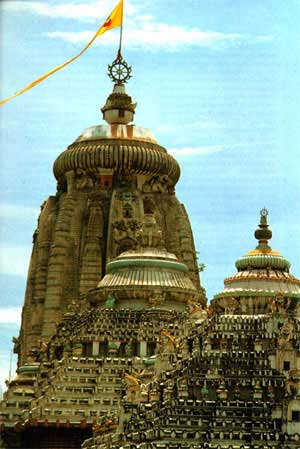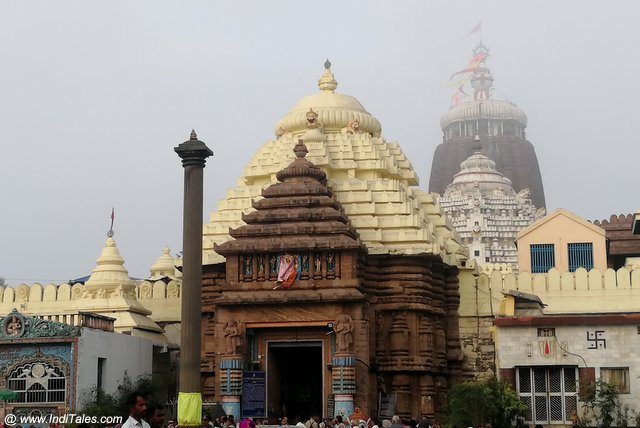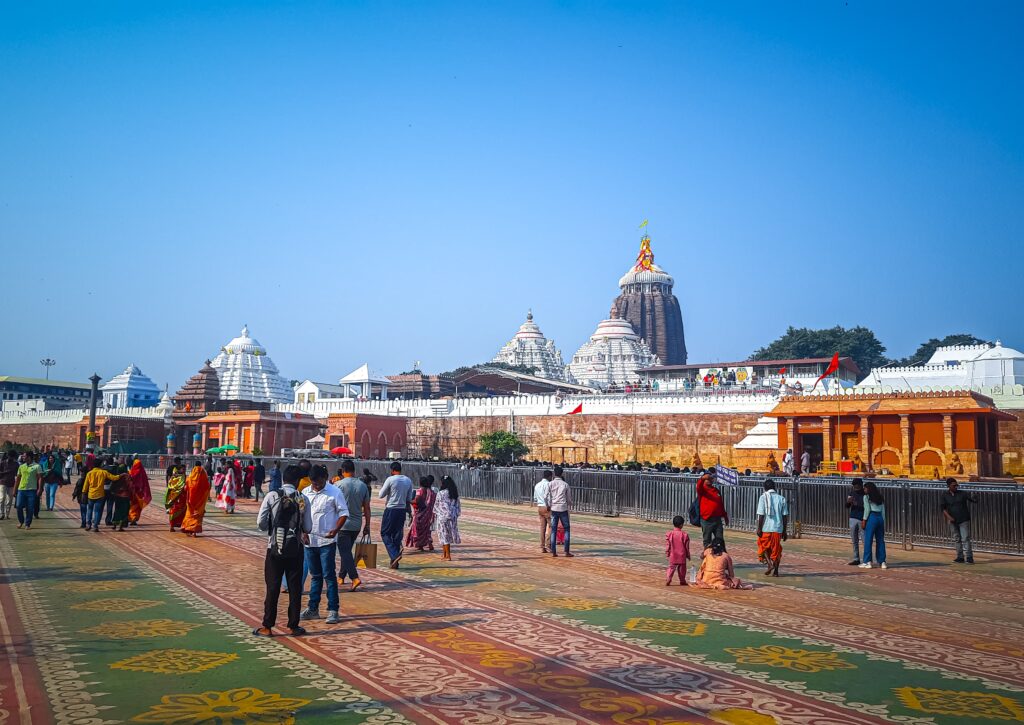
The Majestic Jagannath Puri Temple: A Journey Through Divinity and Culture
Table of Contents
The Jagannath Puri Temple, a marvel of ancient Indian architecture and spirituality, stands as one of the most revered religious sites in India. Nestled in the coastal town of Puri in Odisha, this sacred temple is dedicated to Lord Jagannath, an incarnation of Lord Vishnu. Along with Lord Balabhadra and Goddess Subhadra, Jagannath forms the divine trio worshipped with utmost devotion. The temple’s grandeur, its rich history, and the spiritual aura make it a must-visit for pilgrims and tourists alike. Let’s embark on a captivating journey through this monumental site, unraveling its mysteries, traditions, and significance.
A Glimpse into the History

The origins of the Jagannath Puri Temple date back to the 12th century when it was built by King Anantavarman Chodaganga Deva of the Eastern Ganga dynasty. According to historical records and legends, the construction of the temple marked a significant milestone in establishing Puri as a major pilgrimage site.
The temple’s mythology is equally fascinating. It is believed that Lord Vishnu manifested as Lord Jagannath to grant darshan to his devotees in a wooden form. The story of how the deities were carved by a divine carpenter, under strict conditions, adds a mystical charm to the temple’s lore.
The temple has also witnessed the passage of time, surviving invasions, natural calamities, and cultural shifts, yet standing as a testimony to enduring devotion and artistry.
Architectural Splendor
The Jagannath Temple is an architectural masterpiece, showcasing the quintessential Kalinga style of temple design. Towering at a height of 214 feet, the main sanctum (Sri Mandir) is adorned with intricate carvings and sculptures that depict tales from Indian epics like the Mahabharata and Ramayana. The complex consists of four main structures:
- The Vimana (Main Sanctum): This is where the deities reside.
- The Jagamohana (Assembly Hall): Pilgrims gather here for prayers.
- The Natamandira (Dance Hall): Used for temple rituals and dance performances.
- The Bhoga Mandapa (Offering Hall): Where the temple’s famous Mahaprasad is offered and distributed.
The temple’s gates, adorned with rich carvings and sculptures, lead devotees to an otherworldly experience. The 22-step flight known as “Baisi Pahacha” adds a symbolic touch, signifying the journey toward enlightenment.
Adding to its splendor is the temple’s distinctive white and red exterior, which reflects both purity and vibrancy, visible from a distance, creating a sense of anticipation and awe among visitors.
Spiritual Significance
The Jagannath Puri Temple holds a special place in Hinduism as one of the four sacred Char Dham pilgrimage sites, alongside Badrinath, Dwarka, and Rameswaram. It is believed that visiting these four sites cleanses a person of all sins and helps attain salvation (moksha).
Lord Jagannath is considered a universal deity, transcending caste, creed, and religion. His wooden idol represents simplicity and inclusivity, resonating with millions of devotees worldwide. The temple’s rituals, festivals, and daily prayers create a spiritual ambiance that captivates every visitor.
Many devotees share profound spiritual experiences upon visiting the temple, recounting moments of divine connection and unexplainable serenity. Such stories add to the temple’s allure, drawing pilgrims from far and wide.
The Famous Rath Yatra
No discussion about the Jagannath Temple is complete without mentioning the grand Rath Yatra (Chariot Festival). Held annually during the month of Ashadha (June-July), the Rath Yatra sees the deities Lord Jagannath, Lord Balabhadra, and Goddess Subhadra placed on colossal chariots and paraded through the streets of Puri.
This vibrant festival symbolizes the journey of the deities to their garden house (Gundicha Temple) and back. The chariots, intricately decorated and pulled by thousands of devotees, showcase the unity and devotion of the masses. Witnessing the Rath Yatra is considered highly auspicious, and it attracts pilgrims and tourists from across the globe.
The fervor of the festival extends beyond Puri, with live broadcasts allowing millions worldwide to partake in the celebrations virtually. Stories of people overcoming obstacles to witness this event add to its legendary status.
Mystical Elements of the Temple
The Jagannath Temple is shrouded in mysteries that defy scientific explanations. Some of these intriguing phenomena include:
- The Sudarshana Chakra: The temple’s top is adorned with a chakra (disc), which always appears to face the onlooker, irrespective of their position.
- The Flag Mystery: The temple’s flag atop the dome always flutters against the wind’s direction.
- No Shadow: The temple’s shadow is said to be invisible at any time of the day.
- Prasadam Miracle: The temple’s kitchen, known as the world’s largest, prepares Mahaprasad for thousands daily, yet there’s never any wastage.
These enigmatic aspects spark curiosity and enhance the temple’s reputation as a place of divine wonder. Devotees often share personal encounters with these phenomena, deepening their faith.
The Culinary Delight: Mahaprasad
Mahaprasad, the sanctified food offered at the Jagannath Temple, is an integral part of the temple’s culture. Prepared in earthen pots using firewood, the prasadam includes rice, dal, vegetables, and sweets. The uniqueness of Mahaprasad lies in its preparation and distribution:
- Cooked in a massive kitchen with 752 chulas (stoves), the prasadam is prepared in layers of earthen pots.
- The food is considered divine, and consuming it is believed to bestow blessings.
Visitors often describe the experience of partaking in Mahaprasad as deeply spiritual, with its flavors resonating with the essence of devotion. Sharing this food with others strengthens bonds and fosters a sense of community.
Festivals and Celebrations
Apart from the Rath Yatra, the temple celebrates numerous festivals throughout the year. Some notable ones include:
- Snana Yatra: The annual bathing ceremony of the deities.
- Chandan Yatra: Celebrated to mark the onset of summer.
- Nabakalebara: A rare ritual where the wooden idols are replaced with newly carved ones.
Each festival is accompanied by vibrant rituals, music, and dance, making it a cultural extravaganza.
Devotees often describe the temple during these festivals as a burst of color, energy, and devotion, creating an unforgettable sensory experience.
Preservation and Modern-Day Relevance
The Jagannath Puri Temple is not just a place of worship but a symbol of India’s cultural and spiritual heritage. Efforts are continually made to preserve its architectural integrity and historical significance. The Archaeological Survey of India (ASI) plays a crucial role in maintaining the temple complex.
In today’s era, the temple remains a beacon of faith and devotion. Pilgrims throng the temple to seek blessings, while tourists are drawn to its architectural beauty and mystical aura.
The temple also serves as a hub for cultural exchange, inspiring literature, art, and music. Its continued relevance underscores its role in bridging the past with the present.
How to Reach Jagannath Puri Temple:
- By Air: The nearest airport is Biju Patnaik International Airport in Bhubaneswar, located about 60 km (approximately 1.5 hours by road) from Puri. You can hire a taxi or take a bus to reach the temple.
- By Train: Puri has its own railway station, well connected to major cities like Kolkata, Bhubaneswar, and Chennai. The distance from Puri Railway Station to the temple is about 2 km, which is a short distance and can be easily covered by auto-rickshaw or taxi.
- By Road: Puri is well-connected by road. National Highway 316 connects Puri to Bhubaneswar, which is about 60 km away (around 1.5 hours by road). You can travel by bus, car, or hire a taxi.
Planning Your Visit
If you’re planning to visit the Jagannath Puri Temple, here are some tips to enhance your experience:
- Best Time: October to February is ideal for a pleasant climate. During this period, you can enjoy not only the temple but also Puri’s pristine beaches and cultural events.
- Dress Code: Wear traditional attire as a mark of respect.
- Rath Yatra: If possible, plan your visit around the Rath Yatra to witness the grand celebrations.
- Local Cuisine: Apart from Mahaprasad, explore local delicacies like Puri’s famous seafood and sweets such as Rasagola.
- Nearby Attractions: Don’t miss exploring the Sun Temple at Konark, Chilika Lake, and Pipili, known for its applique work.
Conclusion
The Jagannath Puri Temple is more than just a religious site; it is a living testament to India’s rich cultural tapestry and spiritual legacy. Whether you’re a devout pilgrim or an avid traveler, a visit to this magnificent temple will leave you spellbound. The blend of devotion, architecture, and cultural vibrancy makes it an unforgettable experience. So pack your bags, embark on this divine journey, and let the blessings of Lord Jagannath guide you toward peace and prosperity.
With its timeless appeal and profound significance, the Jagannath Puri Temple invites you to immerse yourself in its magic, offering an experience that resonates deeply within the soul.

